Unleash the Power of Your Raspberry Pi 5 - A Comprehensive Guide to Expansion HATs
Introducing the Raspberry Pi 5, the newest version of the popular single-board computer that combines remarkable processing capabilities with enhanced features. However, its true strength lies in its expandability through Hardware Attached on Top (HAT) boards. These versatile HATs unlock a multitude of functionalities, allowing your Pi 5 to excel in a wide array of projects. In this article, we will delve into different categories of HATs, examining their unique features, pricing details, and available purchasing options. Additionally, we will provide a convenient comparison table to assist you in making informed decisions.
Hardware Attached on Top (HAT) boards are specialized add-on boards meticulously crafted to seamlessly integrate with the Raspberry Pi 5. These boards establish a direct connection to the GPIO (General Purpose Input/Output) pins, enabling the expansion of your Pi 5's capabilities with an assortment of features such as displays, sensors, communication modules, and beyond. With this modular design, you have the freedom to tailor your Pi 5 to a diverse range of applications, including robotics, weather stations, media centers, and even ambitious AI projects.
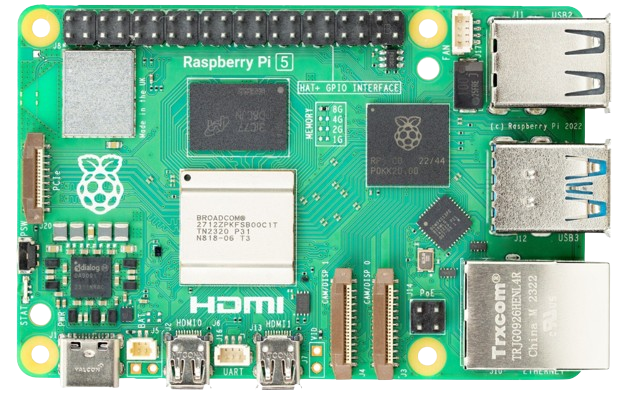
Benefits of Using Raspberry Pi 5 HATs
Here are the main points about HATs and their benefits for the Raspberry Pi 5:
Enhanced Functionality: HATs greatly expand the capabilities of your Pi 5, providing the ability to interact with the physical world through sensors, display information visually, and connect to various networks.
Simplified Development: HATs often come pre-programmed with drivers and libraries, making the development process more straightforward by eliminating the need for complex hardware configuration.
Modular Design: The modular nature of HATs allows for effortless swapping, enabling you to adapt your Pi 5 for different projects without the need to purchase an entirely new board.
Cost-Effectiveness: Compared to building custom hardware solutions, HATs offer a cost-effective way to add desired functionalities to your Pi 5, saving both time and money.
By incorporating HATs into your Raspberry Pi 5 setup, you can harness their enhanced functionality, simplified development process, modular design, and cost-effectiveness to create innovative projects and explore new possibilities.
Types of Raspberry Pi 5 HATs
When it comes to Raspberry Pi 5 HATs, the possibilities are nearly endless. Here are several types and categories of HATs available for various projects:
- Sensor Hats: These HATs allow your Pi 5 to interact with the physical world by incorporating sensors such as temperature, humidity, motion, light, or distance sensors.
- Audio Hats: These HATs enable high-quality audio output and input, making them ideal for multimedia projects, voice recognition, or music playback.
- Display Hats: With these HATs, you can enhance your Pi 5 with different display options, including LCD screens, OLED displays, or touchscreens for visual output.
- Motor Control Hats: Motor control HATs provide the ability to control motors, servos, or stepper motors, making them suitable for robotics, automation, or motion-based projects.
- Communication Hats: HATs in this category offer various communication options, such as Wi-Fi, Bluetooth, cellular connectivity, or even LoRa for long-range communication.
- Power Hats: Power HATs focus on efficient power management and can include features like battery charging, UPS (Uninterruptible Power Supply), or power monitoring capabilities.
- Storage Hats: These HATs provide additional storage options for your Pi 5, including SD card expansion, SSDs (Solid State Drives), or even Network Attached Storage (NAS) solutions.
- Prototyping Hats: Prototyping HATs offer a range of general-purpose input/output options, allowing you to connect and experiment with different components or devices for rapid prototyping.
These are just a few examples of the diverse types and categories of HATs available for the Raspberry Pi 5. Each HAT offers unique functionalities and can be combined or customized to suit your specific project requirements.
Sensor HATs for Raspberry Pi 5
These HATs allow your Pi 5 to interact with the physical world by incorporating sensors such as temperature, humidity, motion, light, or distance sensors. Here's a breakdown of some popular options to help you find the perfect sensor companion for your project:
1. Multi-Sensor HATs:
Here are the main points about Sensor Hats for the Raspberry Pi 5:
- Features:
- Integration of a variety of sensors, including accelerometers, gyroscopes, magnetometers, barometers, and environmental sensors such as temperature, humidity, and pressure sensors.
- Applications:
- Ideal for robotics projects, enabling precise motion sensing and control.
- Suitable for weather stations, providing accurate environmental data like temperature, humidity, and pressure.
- Useful for environmental monitoring, allowing the collection of data on multiple physical parameters for analysis and research purposes.
Sensor Hats offer a wide range of sensor options, making them versatile tools for various applications. Whether you're building a robot, setting up a weather station, or conducting environmental monitoring, Sensor Hats for the Raspberry Pi 5 enable you to gather valuable data on multiple physical parameters, enhancing the capabilities of your projects.
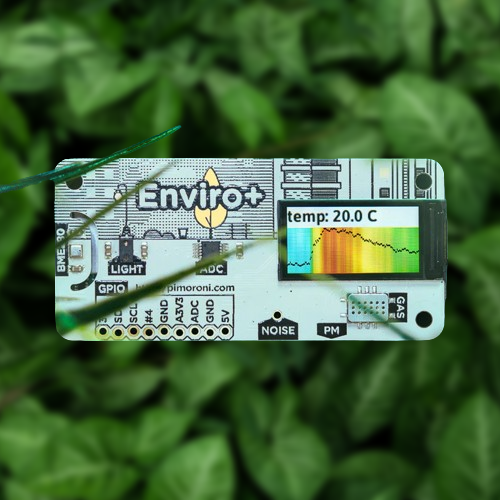
Pimoroni Enviro + HAT: Experience the power of the popular HAT that offers comprehensive environmental data collection. Packed with an accelerometer, gyroscope, magnetometer, barometer, temperature sensor, humidity sensor, and a real-time clock, this HAT delivers a wide range of functionality for gathering detailed environmental information. It's the perfect choice for projects that require accurate and comprehensive data on various environmental parameters.
Price: $68.10
Buy Now: Pimoroni Enviro + HAT
Seeed Studio Grove Base HAT for Raspberry Pi:
Discover the versatility of this HAT, designed to provide a solid foundation for connecting a wide range of Grove sensors. With its modular approach, this HAT allows you to create custom sensor setups tailored to your specific needs and applications. Whether you're working on a robotics project, environmental monitoring, or any other application that requires sensor integration, this HAT offers the flexibility and convenience to build and expand your sensor setup with ease.
Price:$9.99
Buy Now: Seeed Studio Grove Base HAT for Raspberry Pi
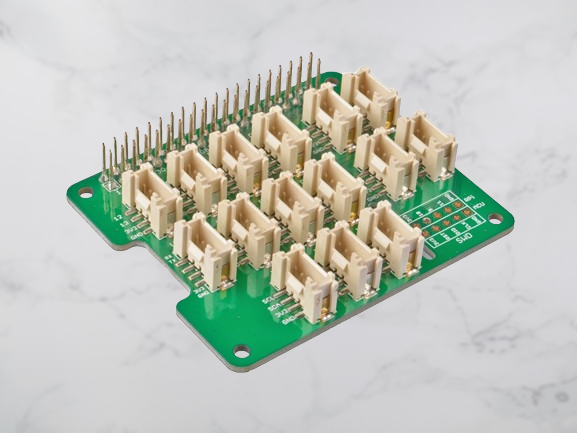
2. Environmental Sensor HATs:
Here are the main points about the features and applications of the sensor integration:
- Features:
- Integration of various sensors such as temperature sensors, humidity sensors, pressure sensors, and light sensors.
- Enables monitoring and measurement of environmental conditions with precision and accuracy.
Applications:
- Ideal for weather stations, providing real-time data on temperature, humidity, pressure, and light levels.
- Suitable for environmental monitoring systems, allowing continuous tracking of environmental parameters for research or analysis.
- Useful for smart home projects, enabling automation and control based on temperature, humidity, and light conditions.
- Beneficial for any project that requires data on temperature, humidity, pressure, or light levels for analysis, decision-making, or system optimization.
The integrated sensors offer a wide range of capabilities, making them valuable tools for various applications. Whether you need to monitor weather conditions, track environmental parameters, create a smart home system, or gather data for your specific project, the sensor integration provides the necessary measurements and insights to enhance your project's functionality and efficiency.
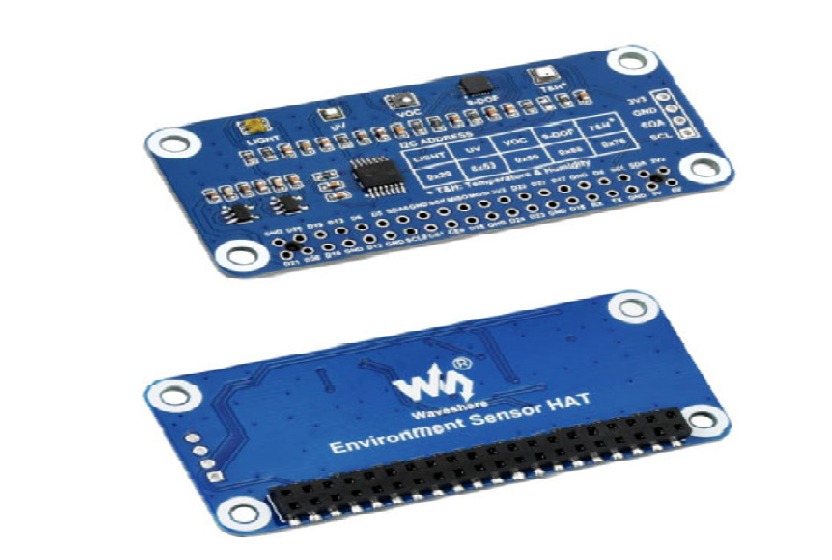
SparkFun Environmental Sensor HAT Kit:
Introducing the HAT kit that offers a comprehensive suite of environmental sensors. This kit includes temperature, humidity, pressure, light, and VOC (Volatile Organic Compound) sensors, providing a diverse range of capabilities for collecting environmental data. With this HAT kit, you can gather valuable information about temperature, humidity, pressure, light levels, and even air quality, enabling you to monitor and analyze the environmental conditions in your projects and applications.
Price: $26.99
Buy Now: SparkFun Environmental Sensor HAT
MakerHawk BMP280 Barometric Sensor HAT:
Experience the power of the popular HAT that offers comprehensive environmental data collection. Packed with an accelerometer, gyroscope, magnetometer, barometer, temperature sensor, humidity sensor, and a real-time clock, this HAT delivers a wide range of functionality for gathering detailed environmental information. It's the perfect choice for projects that require accurate and comprehensive data on various environmental parameters.
Price: $68.10
Buy Now: MakerHawk BMP280 Barometric Sensor HAT

Audio HATs for Raspberry Pi 5
Basic sound improvement boards can add headphone jacks andamped speakers for playing music and videos with better volume andclarity. Audiophile boards take it to another level with high-res audioDACS, advanced amplifiers and connections for external DACs and ampsto deliver true hi-fi playback through speakers or headphones. Thereare boards for every budget, from simple upgrades to cinephile-gradeHome Theater Audio solutions. With the right HAT, your Pi can rival asoundbar or dedicated music streamer:
1. Digital-to-Analog Converter (DAC) HATs:
- Features:
- These boards integrate high-quality DAC (digital to analog converter) chips.
- This allows them to take the digital audio signals from the Raspberry Pi 5 and convert them into cleaner and more accurate analog audio signals for playback.
- The upgraded DAC chips mean you'll enjoy improved sound quality whether you use speakers or headphones to listen.
- Application
- These HATs are great for boosting the sound quality when listening to music, streaming audio, or working on multimedia projects with your Pi 5.
- They provide a noticeable upgrade over the standard audio performance you get from the Pi's built-in capabilities. Whether you want richer sound for Spotify playlists or clearer dialogue for movies and videos, an external sound card HAT can take your Pi's audio to the next level
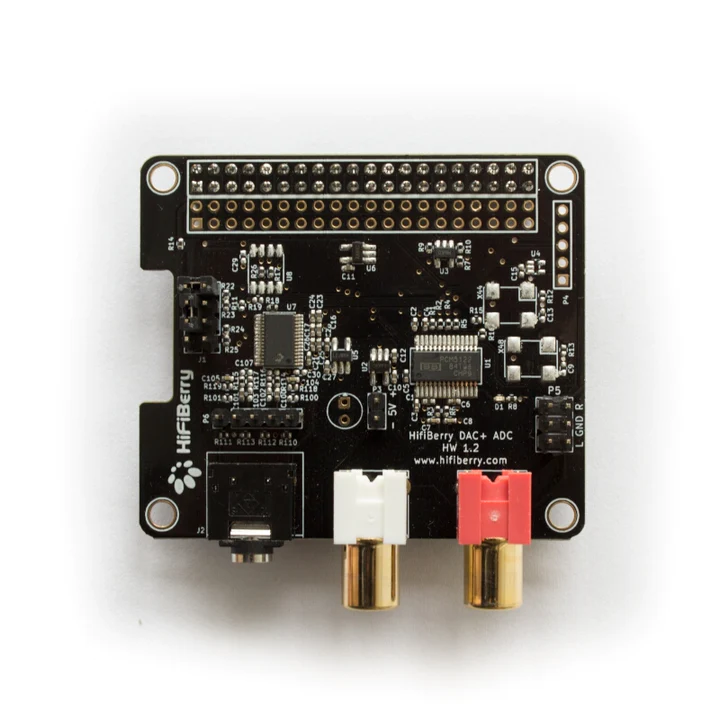
HiFiBerry DAC+ ADC:
The DAC+ ADC is equipped with a stereo analogue input that can be configured for a wide range of input voltages. It performs best with line-level analogue sources. However, it is also possible to use it as a microphone input.
- You can only use dynamic microphones. Microphones that require a power supply are not supported.
- The microphone output voltage is very low. This means you need to amplify it. The DAC+ ADC has the necessary pre-amplifier already equipped. You will have to set the jumpers correctly.
- The sound from the input won’t be played back automatically on the output. You will have to use some software that reads the input and outputs it again
Price: $89.95
Buy Now: HiFiBerry DAC+ ADC
IQaudio AMP Pro:
IQaudio AMP Pro: For around $55, this board packs a powerful Class-D amplifier that can drive higher-wattage speakers. It's suitable for those looking to create a true high-fidelity audio experience. The high output capabilities of the amp make it a good choice for powering larger speakers that demand more juice.
Price: $20
Buy Now:IQaudio AMP Pro
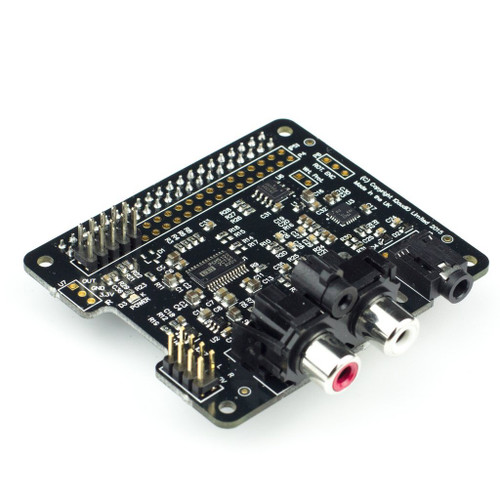
Display HATs for Raspberry Pi 5
The world of HAT displays is quite diverse, with different options available in an assortment of shapes, sizes and feature-sets. Each has been designed with specific projects in mind. To help you pick the ideal display partner for your Pi 5 project, here's an overview of the key display HAT types:
1. LED Matrix HATs:
- Features:
- These displays use an array of LED pixels to show text, simple graphics and animations.
- They tend to be small and compact, making them a good fit for projects where space and power consumption are limited. Since the display is made up of individual light-emitting pixels, it can render basic shapes and moving images quite effectively.
- The trade-off is lower resolution compared to other options. But for applications like displaying statuses or simple animations, LED pixel displays do the job well in a small package.
- Application
- They work very well for small status displays and alerts, like showing the time, date or device connectivity.
- Scrolling text is also a neat effect you can create. These displays also shine in miniature information dashboards, whether hung on a wall or integrated into a larger project.
- Retro gamers love them too – their pixelated look is ideal for replicating older gaming systems. So if you need crisp numbers, short messages or 8-bit style graphics, a compact LED matrix could be just the ticket.
Adafruit RGB Matrix HAT
This HAT is a popular choice thanks to its 32×32 RGB LED matrix. That's over 1,000 individual pixels each controllable for color, allowing for vibrant animations, scrolling marquees and more. The level of control over each pixel means you can really get creative. Whether you want pulsating color patterns or smooth scrolling text and graphics, this display is up to the task. At around $20, it provides a huge canvas for visual projects without breaking the bank. The large matrix makes it ideal for attention-grabbing displays or animations where color is king
Pimoroni Pico Display Pack
This kit pairs a 64×64 LED matrix display with Pimoroni's own Pico microcontroller board. At just under 3 inches square, the display is compact yet provides over 4,000 addressable LEDs for graphics and text. What's great is this bundle puts the power of a programmable Pico alongside it. This opens up more flexible project options compared to HATs using a Pi's fixed GPIO pins. For around $25, you get the display, Pico and everything needed to start coding versatile visual builds. The Pico adds wireless connectivity and a wealth of community libraries too. It's a nice self-contained option for portable or standalone LED-based projects
2. LCD HATs:
- Features:
- LCD HATs provide a more conventional screen experience compared to LED matrices.
- They offer higher resolution visuals that are sharply defined and easy to read even in bright conditions.
- Some common LCD panel sizes used include 160×128, 320×240 and 640×480 – far exceeding the pixel count of RGB LED displays. The tradeoff is they consume more power and typically don't support full color like an LED matrix.
- But if your project involves displaying detailed photos, webpages or GUI interfaces, an LCD is a better choice for its improved clarity and resolution over smaller LED options.
- Application
- LCDs really shine for projects involving user interfaces and detailed readouts.
- Their higher resolution screens open up possibilities for building custom control panels and configuration interfaces.
- Sensor readouts, charts displaying real-time data over time, and GUI programs also benefit from the legibility of an LCD.
- They're great for DIY media centers too, whether as a mini TV, digital photo frame or gameplay monitor.
- LCDs are also well-suited to education projects, clearly showing diagrams, formulas, videos and more to aid learning.
- So if your use case involves viewing detailed graphics, text or interfaces, an LCD HAT can make those visuals pop.
Waveshare 3.5″ LCD HAT:
- Available for around $30, this HAT packs an impressive 3.5-inch LCD into a small footprint. With a resolution of 320×480 pixels, there's plenty of space to clearly show off text, images, simple charts and more. The sizable screen gives you room to work yet remains compact enough for various projects. The pixels are densely packed, making it an excellent economical choice for displaying visual information with clarity and ease. Whether you need eye-catching temp/sensor reads, a GUI for controls, or just a mini digital photo frame, this HAT delivers quality LCD viewing at a budget-friendly price point.
Elecrow 5″ IPS LCD HAT:
- For projects requiring an even more spacious screen, consider the Elecrow 5-inch IPS LCD HAT. It upgrades you to a wider 5-inch display with a resolution of 800×480 pixels. What's notable is this LCD uses IPS (in-plane switching) technology, providing 178-degree viewing angles both horizontally and vertically. Text and imagery stay crisp and clear from nearly any angle. When size and readability matter most, like a digital signage display, this HAT really delivers. It maintains the affordability too, coming in at around $40. The larger real estate and sharper screen make it well-suited for multimedia, presentations and interactive exhibits.
3. OLED HATs:
- Features:
- OLED HATs use Organic Light-Emitting Diode technology, which allows for vivid, high-contrast colors and exceptionally deep blacks.
- Unlike LCD screens, OLED pixels illuminate themselves, providing wide viewing angles that remain crisp from any position, even in low-light environments. They also tend to be slim and energy-efficient.
- Some other advantages of OLED include fast response times and the ability to create transparent displays. While typically more expensive than LCD, for applications where picture quality is paramount, an OLED HAT delivers a brilliant visual experience.
- Application
Thanks to their vivid colors and high contrast in any lighting, OLED screens are perfect for crisp user interfaces and dashboard displays. Their wide viewing angles mean the content stays clear whether you're peering straight on or from an angle.
Portability is also a strong suit. Their small, trim footprint and efficient power usage allow for extended battery life in mobile devices. Anything from wearables to handheld electronics can benefit.
Digital signage is another great application. OLEDs produce deep blacks for crisp text and graphics even in bright store displays or public spaces. Transparency effects also open up interactive possibilities.
When picture quality, visibility and efficiency within a compact design are important, few display technologies can beat OLED. They're ideal for anything wanting to combine eye-catching visuals with versatility

